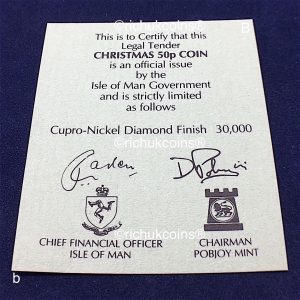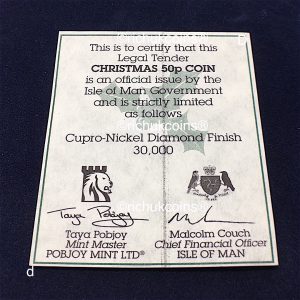Published on
Last Updated on:
The story started in 1980. What was story about? Indeed, you need to know more about Isle of Man modern coins, so that you then have to ask yourself what had happened in and before 1980? Do not forget that the Pobjoy Mint (established in 1960s) are a specialist in modern coins. The die letters (or batch codes) originally were found on 1978 IOM £1 coins and then expanded on all IOM denominations in 1979 onwards. Later soon, the Mint had earned their reputation in the numismatic world in 1980 by attending the New York Viking Exhibition Show. From the perspective of business, they only take 5 years to reach a peak of a business circle.
Normally, I do not conclude precious mental coins struck at the Pobjoy Mint within topics I have mentioned here. Because the Royal Mint precious metal coins are made much better than the Pobjoy Mint in terms of British modern coins. However, the Pobjoy Mint really do a great job than the Royal Mint if you look back at non-precious metals (i.e., CN).
Now, let we get straight into the point above. But we need to know what coins are first. Therefore, let we have a look at silver coins of the world first xmas silver coins associated with die letter D and E respectively struck at the Pobjoy Mint.
- 1980 IOM Xmas 50p Proof silver coin with D die letter (Proof grade).
- 1980 IOM Xmas 50p Proof silver coin with E die letter (Proof grade).




Note: From above, D die silver and E die silver are different in terms of coin finish or coin quality. D die silver coin looks more frosted on portrait.
Above pictures it shows the difference between the D die letter silver coin and the E die letter silver coin. At first glance, the E die letter grade is better than the D one. Why do I have two different die letters presenting here? This is simple to answer: go back to look at 1978 IOM £1 silver coins. Indeed, they keep so-called “consistency” between 1978 and 1980. Simultaneously, the existence of the BC die letters for both years. Based on the two strings noted on silver coins, it is not hard to follow two series on Cupro-Nickel (CN) coins. One string is for the Prefix A and another the Prefix B. Also, from this point, it is not to hard to follow circulating commemorative and commemorative coins. For instance, circulating commemorative coins = the Prefix A; commemorative coins = the Prefix B. Under the Prefix A, it has AA, AB, AD & AE and BC, BD, BF & BB under the Prefix B in 1980. (Notice: the AC is not showing here because of the existence of BC within the Xmas series. However, most importantly, the AC is adapted on the 1980 NY Viking show 50p library finish coin. Clearly, the closest letter of D is E under the Prefix A, the E die letter presents here.)
My personal interest is not Xmas 50p coins under the Prefix A, and only the Prefix B xmas coins. The so-called diamond finish coins are just fit into the gap in the UK numismatic world. Because they are quite enjoyable in terms of money spent and non-precious metal related coins. My understanding on a diamond finish standard is that a). polished blanks used; b). no proof die used during the striking process and c). press once time. As a result, no frosted relief and no mirror-liked field.
However, IOM Xmas 50p coins with the BF and BB die letters somehow have got my attention. Let we talk the BF coins first and then the BB coins.
The BF coins. The BF coins below are highly correlated with the BF Mule coins, which I have talked them a lot under categories of IOM Xmas.
- 1980 IOM Xmas 50p Diamond Finish with BF die letter (version 1) (Proof grade).
- 1980 IOM Xmas 50p Diamond Finish with BF die letter (version 2) (Proof grade).
- Version 1 vs. Version 2 — The difference between the two versions above.






Note: it is normal BF coins above with the correct obverse along with a very small error noted on reverse. However, the (real) BF coins with the incorrect obverse having the same error as seen from Version 1 are the stateless 50p mule coin.
The BB coins. The most unusual things the Pobjoy mint made at the beginning of the creation of the Xmas series are using BB die letters and BC die letters. They send data BC die letters as diamond finish coin in Krause book (#KM). However, in reality, it has the existence of BB die letters.
- 1980 IOM Xmas 50p Diamond Finish with the BB die letter (version 1) (Proof grade).
- 1980 IOM Xmas 50p “Diamond Finish” with the BB die letter (version 2) (Prooflike grade).




Note: considering the two (V1 & V2) above are coins both associated with BB, but they have a decrease quality in grade.
Based on the story of the BF die letters, it is getting more clear here. They definitely had made an ERROR in 1980 because of attending the 1980 NY Viking show. But, why there was NO a collector to dig this story out in public? One thing is for sure that the IOM Xmas theme related 50p coin is getting popular and the Xmas theme on coins it has a big market here in the UK. However, it takes 35 years to reach this point from 1980 to 2014 with the majority of people born 1980s and 1990s.
To myself, it is quite clear that the AC missing under the Prefix A, and still searching the BE under the Prefix B. No matter what is in the Prefix A or the Prefix B on IOM Xmas 50p coins, they are showing only 4 sequences. Also, it is quite clear to me on this bit. In order to have a clear and better picture of my understanding here, you probably do need go through different topics under categories. All things happened in 1980 are extremely and highly correlated each other. That is the point they got them far further deep in this industry in 1980. But, sad, very sad, it is that everything it has an end after it starts. Remember The Pobjoy Mint once only get permissions from Tynwald, and they then have rights to mint IOM coins. In other words, Tynwald is only the big boss to them.
#The End






















